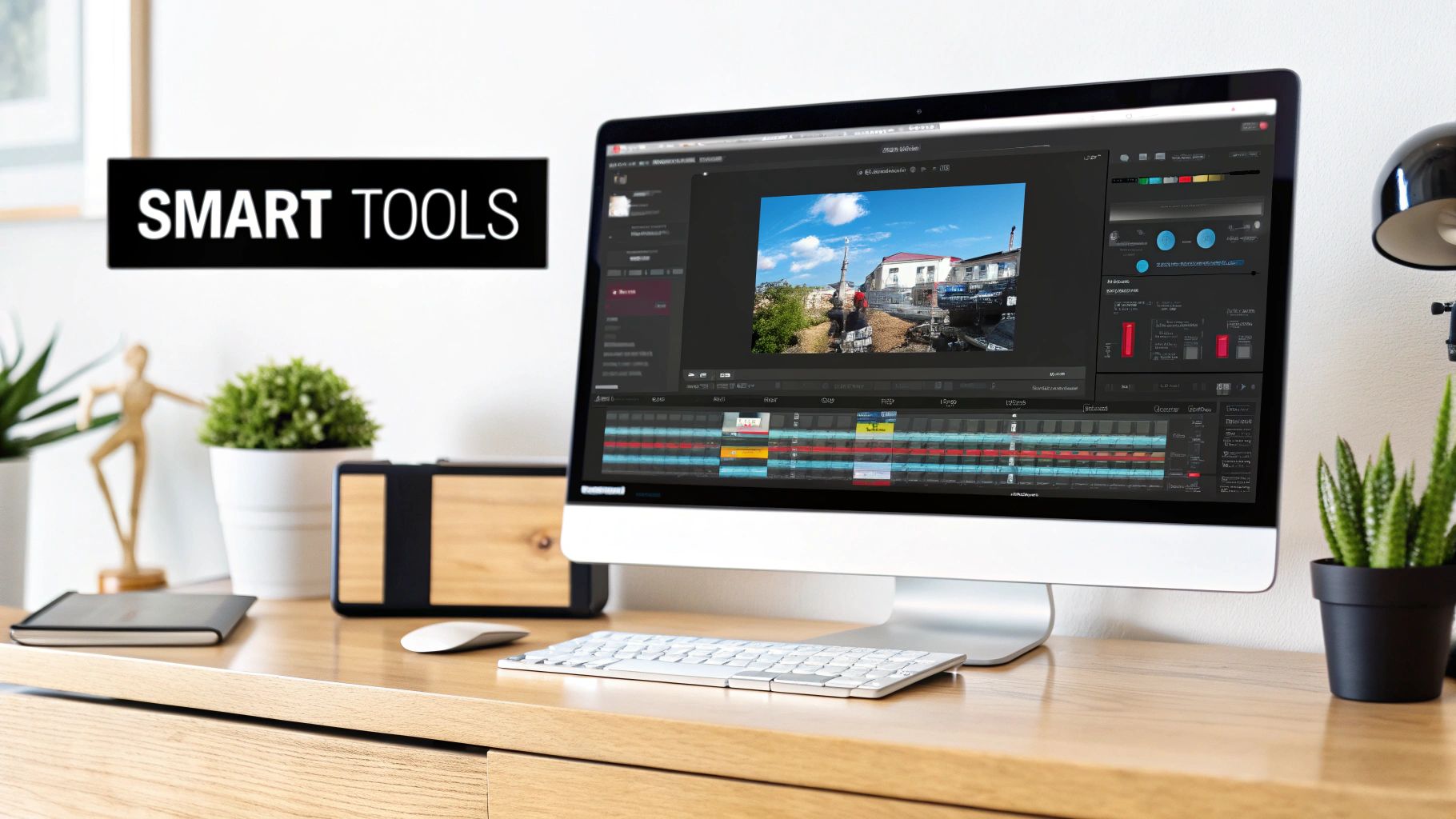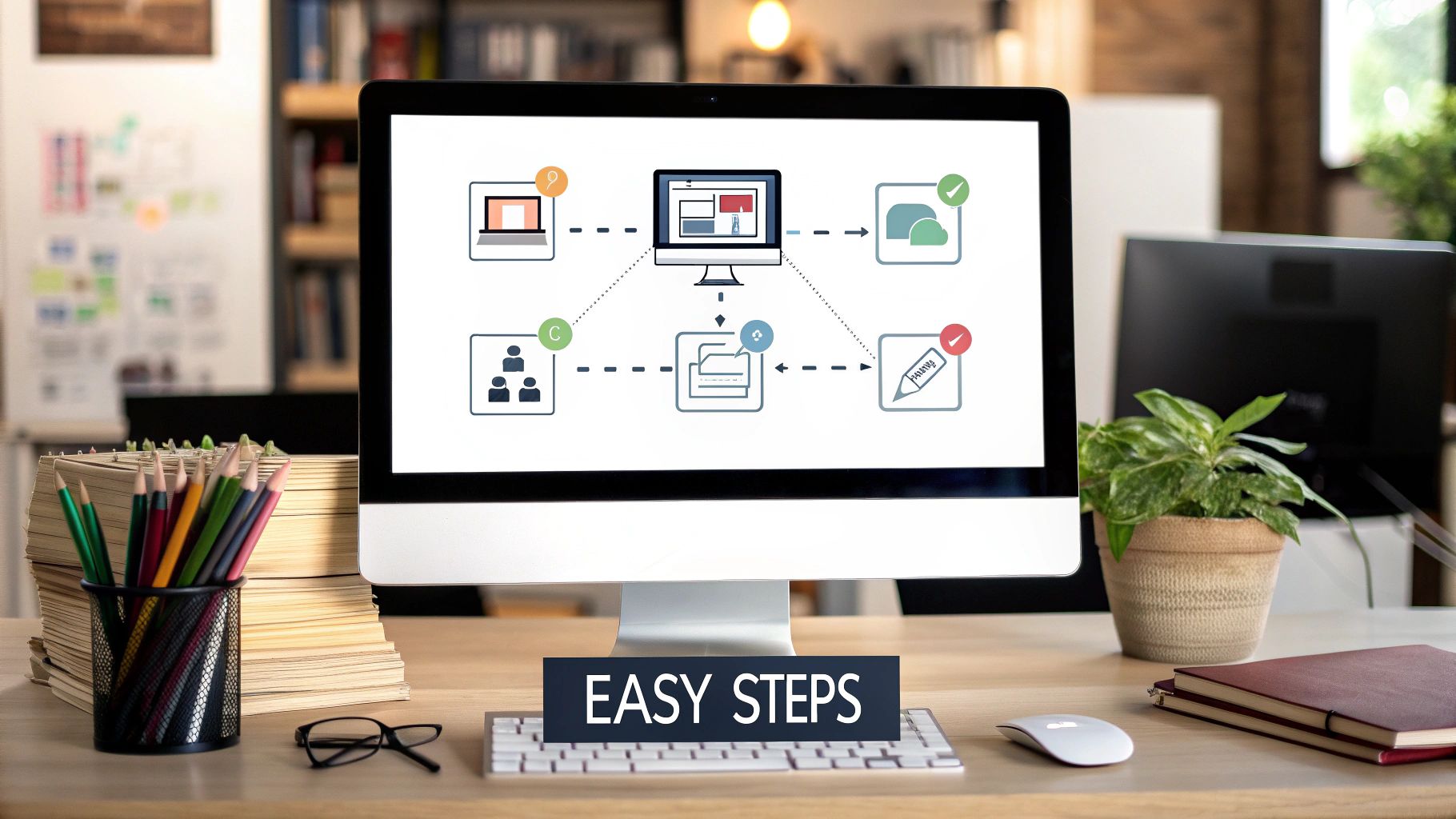Compress Video for Email: Quick & Easy Guide
Understanding Email Size Limitations
Before getting into the specifics of video compression for email, it's important to understand why compression is even necessary. Email providers set size limits on attachments to manage storage space and bandwidth on their servers. These limits can really impact how you share videos via email. Sending large video files often leads to bounced emails or delivery failures, which can hinder your communication.
Common Email Attachment Size Limits
Different email providers have different size restrictions. Gmail and Yahoo Mail generally allow attachments up to 25 MB. Outlook, on the other hand, often has a 20 MB limit. If you exceed these limits, your email might be rejected by the recipient's server. Even if the email does get through, large attachments can clutter inboxes and cause frustration. This highlights the importance of compressing videos before sending them via email.

Why Size Matters
Understanding email provider limitations is crucial for successful video sharing. Gmail allows a maximum attachment size of 25 MB, while Outlook limits attachments to 20 MB. Video compression requires balancing resolution, bitrate, and frame rate to achieve a manageable size without sacrificing quality. A bitrate between 5,000-10,000 kbps and a frame rate of 24-30 FPS are often effective. Choosing the right video format, typically MP4, is also important for compatibility. Testing compression settings and considering video hosting platforms like YouTube or Vimeo can further streamline the sharing process. For a deeper dive into compressing videos for email, check out this helpful resource: Compress Videos for Email
Handling Oversized Attachments
Many email providers offer solutions for sending large files. If you try attaching a video that's too big in Gmail, you'll likely be prompted to upload it to Google Drive and share a link. Outlook similarly integrates with OneDrive. This method bypasses attachment limits and improves the recipient's experience. Remember to configure sharing settings correctly so the recipient can access the video. This paves the way for smooth video sharing, ensuring your content reaches your audience without any issues.
Proven Methods to Compress Video For Email
Sending videos through email can be tricky. File size limitations are often a hurdle. But by compressing your videos effectively, you can share engaging content without bounced emails or slow downloads. This lets you use video in your email marketing without overwhelming inboxes.
Balancing Quality and File Size
Successfully compressing videos for email means finding the right balance between quality and file size. Imagine packing a suitcase – you want to bring everything you need without exceeding the weight limit. The same idea applies here: retain the essential visual and audio information while minimizing the file size for easy email delivery.
- Resolution: Lowering the resolution from 1080p to 720p or even 480p can dramatically reduce file size. 720p usually strikes a good balance for email videos.
- Bitrate: This controls how much data is used per second of video. Lowering it shrinks the file, but can also impact quality. Experiment to find the best setting.
- Frame Rate: A lower frame rate (like 24 fps instead of 60 fps) makes smaller files. Unless your video needs smooth, fast action, a lower rate often works.
- Video Format: MP4 is generally the best format for email because it's widely compatible and compresses well.
For more tips on optimizing various file types without compromising quality, check out this guide: How to master file size reduction.
Choosing the Right Compression Method
Compressing videos for email usually involves a combination of techniques. Converting videos to compressed formats, lowering resolution to 720p or 480p, reducing bitrate, and trimming video length are all effective. Sharing videos through hosting platforms, instead of as attachments, bypasses email size limits completely. Learn more here: Learn more about video compression for email best practices.
Compression Software and Tools
Several tools can help you compress video for email. Here are a few popular options:
- HandBrake: A free, open-source video transcoder offering granular control over compression settings.
- VLC Media Player: This versatile media player also handles video conversion and compression.
- QuickTime Player: Mac users can use QuickTime Player to export smaller video files.
- Online Video Compressors: Many online tools compress videos directly in your browser, no software installation required.
For more on managing videos and other attachments within your email workflow, consider these proven email management strategies. These strategies can help streamline your workflow and improve your overall productivity.
The best tool for you depends on your specific needs and technical skills. Try a few different options to find what works best.

To help you understand the different approaches to video compression, we've put together a comparison table:
Compression Methods Comparison: This table compares different video compression methods and their effect on file size and quality.
| Compression Method | Size Reduction | Quality Impact | Best For |
|---|---|---|---|
| Lowering Resolution (e.g., 720p) | Significant | Noticeable, but often acceptable | Email, web sharing |
| Reducing Bitrate | Moderate to High | Can be significant if set too low | Balancing size and quality |
| Lowering Frame Rate (e.g., 24 fps) | Moderate | Noticeable in fast-paced videos | Videos with limited motion |
| Converting to MP4 | Moderate | Generally minimal | Wide compatibility |
Key takeaway: Choosing the right compression method depends on your video content and how you'll use it. By compressing your videos effectively, you can make sure your email marketing is both engaging and reaches your audience's inbox.
Essential Software to Compress Video For Email

Now that we understand effective video compression methods, let's look at the software that makes the process easy. Choosing the right tool impacts both the quality of your compressed video and how efficiently you work. Many options exist, from free basic tools to premium software packed with advanced features.
Free and Accessible Options
If you're just starting or working with a tight budget, several free tools offer excellent compression. HandBrake, a popular open-source video transcoder, gives you a lot of control over compression settings. This is perfect for fine-tuning your video output. HandBrake is a powerful tool for those who want granular control.
Another option is VLC Media Player. Known for playing almost any video format, VLC also has solid video conversion and compression features. Mac users have a convenient built-in option: QuickTime Player. It exports videos in smaller file sizes, perfect for quick compression tasks. Finally, many online video compressors compress videos directly in your browser, avoiding software downloads.
Premium Software for Enhanced Control
Free tools are a great start, but premium software offers advanced features and often a more polished user experience. For example, Compresto is a highly efficient compression tool designed for Mac users. It streamlines file compression across many formats. Features like folder monitoring and a simple drop zone can save you a lot of time.
Premium options generally provide more control over compression settings and often include batch processing and support for advanced codecs. This makes them a worthwhile investment for professionals who frequently work with video.
Choosing the Best Tool for Your Needs
The ideal video compression software depends on your specific needs. Think about your technical skills, budget, and how much control you need over the compression process. For basic compression and a free solution, HandBrake or VLC are excellent choices.
If you want a streamlined workflow and advanced features, and don't mind paying for premium software, Compresto offers a robust solution, particularly for macOS. Trying out different options will help you find the best fit for your workflow and video quality goals.
Mobile Compression Tools
Smartphones are now powerful video creation tools, so mobile compression apps have become essential. These apps, often free with in-app purchases, let you compress videos directly on your iPhone or Android device. This makes sharing videos on the go much simpler. Many offer features like adjusting resolution and bitrate, similar to desktop software.
For example, apps like Compress Videos & Resize Video let you compress single videos for free after watching an ad. Others, like Video Compressor, offer batch processing and compressed video previews. Understanding what these mobile tools can do is vital for anyone creating and sharing videos from their phone.
Cutting-Edge Compression Technologies

Successful video email marketing relies on understanding the latest in video compression. It's about more than just the basics; it's about exploring technologies that truly improve how we shrink video files for email. This helps deliver high-quality visuals without bumping into those annoying attachment size limits.
Modern Codecs: H.265 and AV1
Video compression is always improving, with new codecs constantly being developed. High-Efficiency Video Coding (HEVC), also known as H.265, is one major advancement. H.265 delivers impressive compression, achieving 25% to 50% better data efficiency than its predecessor, H.264, while maintaining video quality. By 2019, 43% of video developers were already on board with HEVC. This shows how effective it is for smoother playback, even on slower connections. HEVC is also future-proof, supporting resolutions up to 8K, which solidifies its place as a top codec. For more on video email data usage, see: How Much Data Does Video Email Use?
Another strong contender is AV1, an open-source, royalty-free codec built for high-quality web video. This makes it a budget-friendly choice for businesses. You might also find this comparison helpful: H.264 vs. H.265: Which Codec Should You Use?
Adaptive Bitrate Streaming and Content-Aware Encoding
Beyond codecs, other techniques improve the viewer's experience. Adaptive Bitrate Streaming (ABR) changes the video quality on the fly based on the viewer's internet speed. It's like a chameleon adapting to its surroundings. This keeps playback smooth, even when bandwidth fluctuates.
Content-aware encoding, on the other hand, optimizes compression based on what's actually in the video. More data goes to complex scenes and less to simpler ones, maximizing quality while keeping file size down.
Practical Applications for Email Campaigns
These advanced technologies have real benefits for email campaigns. Better compression means smaller files, which reduces bounced emails. ABR keeps videos playing smoothly for everyone, no matter their internet speed. Content-aware encoding maintains quality, keeping viewers engaged. By understanding and using these techniques, your video email marketing can become significantly more effective.
Maximizing Video Email Marketing Results
Compressing video for email isn't just a technical requirement. It's a strategic way to improve your marketing outcomes. Proper compression ensures smooth playback and maximizes audience engagement, leading to better conversion rates and a stronger return on your video marketing investment.
The Power of Optimized Video in Email
Your video thumbnail is like a storefront window – it’s the first thing people see. A compelling thumbnail and a concise subject line can significantly boost your email open rates. Once opened, a well-compressed video plays seamlessly, capturing your audience and effectively delivering your message.
This increased engagement translates into tangible results. Video in email marketing has become incredibly popular. Embedding videos can increase open rates by up to 19% compared to text-only emails, as reported by Campaign Monitor. Click-through rates can also see a boost of up to 65%, according to Forrester. About 90% of marketers now use video in their email campaigns, seeing increased engagement, broader social media reach, and improved tracking of email metrics. Want to delve deeper into the numbers? Check out these Video Email Marketing Statistics.
Elements of High-Converting Video Emails
Successful video email campaigns depend on several key factors. Optimal video length is crucial. Aim for short, concise videos that quickly grab attention and provide value. Thumbnails should be visually appealing and directly related to the video content. The video’s placement within your email template also matters. Position it prominently to ensure maximum visibility.
Don't forget to include a clear call to action within or immediately after your video. Guide viewers toward the desired next step, whether it's visiting your website, making a purchase, or subscribing to your newsletter. This focused approach turns viewers into customers and maximizes conversions.
For tips on optimizing videos for other platforms, check out this guide: How to master optimizing videos for social media.
Measuring and Optimizing Performance
Tracking basic metrics like open and click-through rates is a good start. However, top marketers dig deeper, analyzing video completion rates, watch time, and social shares. These metrics provide a more complete picture of viewer engagement.
A/B testing different video lengths, thumbnails, calls to action, and even subject lines allows for data-driven improvements. By constantly experimenting and refining your strategies, you can pinpoint what resonates with your audience.
Let’s take a closer look at how video impacts key email metrics. The table below illustrates the improvements seen when incorporating video into email campaigns.
Video Email Marketing Performance Metrics Key statistics showing the impact of video in email marketing campaigns
| Metric | Without Video | With Video | Improvement |
|---|---|---|---|
| Open Rate | 10% | 11.9% | 19% |
| Click-Through Rate | 2% | 3.3% | 65% |
As you can see, adding video to your emails can substantially improve both open and click-through rates. This highlights the power of video in capturing audience attention and driving engagement.
By continuously analyzing and adapting, you can ensure your video email marketing remains effective and delivers a strong return on investment. This allows you to tailor your strategy to achieve the best possible engagement and conversions.
Smart Alternatives to Email Attachments
Sending large video files directly as email attachments can be tricky. Many email providers, like Gmail and Outlook, have size limits of 25MB and 20MB, respectively. Going over these limits can lead to bounced emails or delivery failures. This section explores other ways to share videos without these size restrictions, while also making the viewing experience better for your recipients. You'll be able to share videos effectively and avoid technical problems.
Cloud Storage Solutions: A Seamless Sharing Experience
Cloud storage services like Google Drive, Dropbox, and OneDrive are a great way to share larger videos. You can upload the video and create a shareable link. This link is easy to paste into an email, avoiding bulky attachments altogether. Cloud storage also gives you control over who can access the video with permission settings, adding an extra layer of security.
Video Hosting Platforms: Enhanced Engagement and Analytics
Using platforms like YouTube or Vimeo to host your videos has several advantages. Besides getting around email size limits, it makes your content more engaging. You can embed videos directly into emails for a better visual experience. These platforms also offer helpful analytics, tracking views, watch time, and engagement to show how your audience interacts with your content. This helps measure how well your video marketing strategies are working.
Embedded Video: Streamlined Viewing Within the Email
Embedding a video lets recipients play it directly in their email client. This is more convenient than downloading an attachment. However, not all email clients support embedded video, so testing your email across different clients is essential to make sure everyone can see it correctly. Consider platforms like Descript that provide embedding capabilities which may streamline your video sharing.
Choosing the Right Strategy: Balancing Your Needs
Each sharing method has its own strengths:
-
Cloud Storage: Perfect for sharing large videos, especially with individuals or small groups, while maintaining control over access.
-
Video Hosting: Best for wider distribution, increasing engagement, and gaining insights through detailed analytics.
-
Embedded Video: Creates the best viewing experience, provided it's compatible with your audience’s email clients.
Using a mix of these methods gives you flexibility in different situations. This lets you pick the best approach based on what you're sharing, who you're sharing it with, and any technical considerations.
Compress your videos quickly and easily with Compresto, a powerful compression tool for macOS. Download Compresto today at https://compresto.app and improve your video sharing workflow.